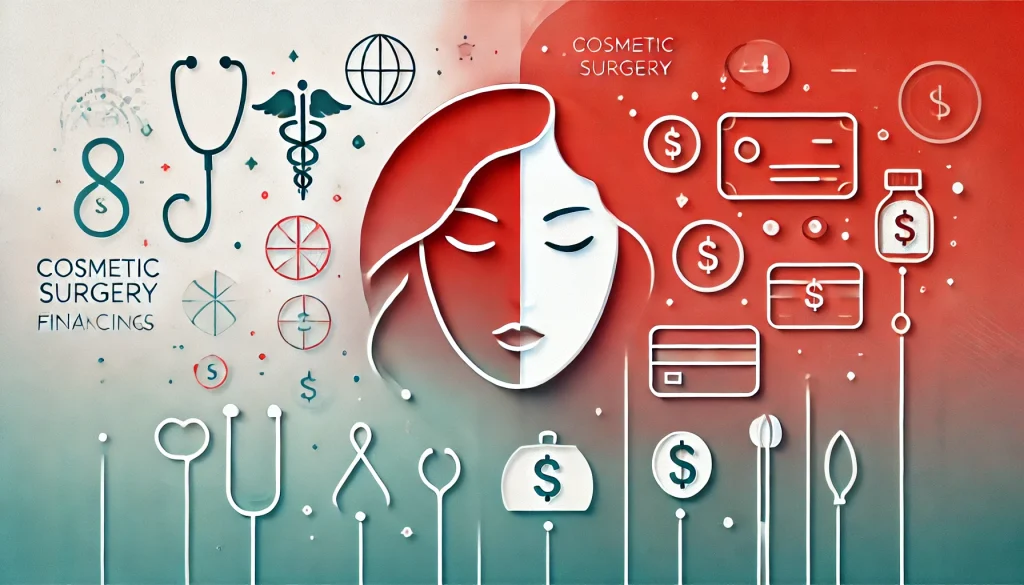Top US Cosmetic Surgery: Financing Guide 2025

US Cosmetic Surgery can be life-changing, boosting confidence and improving self-esteem. However, many prospective patients are concerned about the costs associated with these procedures. While cosmetic surgery is an investment in yourself, it can be financially daunting. Fortunately, there are multiple financing options available in the U.S. that can help make cosmetic surgery more affordable in 2025. In this comprehensive guide, we’ll explore various ways to finance your cosmetic procedure, offering you the tools to make informed financial decisions.
Table of Contents
1. Understanding the Costs of Cosmetic Surgery
US Cosmetic Surgery procedures can range widely in price depending on the type of surgery, the surgeon’s experience, the location of the practice, and the complexity of the procedure. Below is a breakdown of the average costs for popular cosmetic surgeries in the U.S. in 2025:
- Rhinoplasty (Nose Job): $5,000 – $15,000
- Breast Augmentation: $6,000 – $12,000
- Liposuction: $4,000 – $10,000
- Facelift: $7,000 – $20,000
- Tummy Tuck: $8,000 – $15,000
- Botox Injections: $300 – $700 per session
These estimates typically include the surgeon’s fee, anesthesia, and facility costs. However, many patients forget to factor in additional costs like pre-surgical consultations, post-operative care, and medications, which can add several hundred to a few thousand dollars more.
2. Health Insurance and Cosmetic Surgery: What You Should Know
Most health insurance plans do not cover cosmetic surgery since these procedures are considered elective and not medically necessary. However, there are exceptions where health insurance may help offset some costs:
- Reconstructive Surgery: If the surgery is deemed medically necessary, such as breast reconstruction following a mastectomy or correcting a birth defect, insurance may cover a portion or the entire procedure.
- Septoplasty: A functional nasal surgery to correct a deviated septum that impairs breathing may be covered by insurance, although additional cosmetic work (rhinoplasty) would likely not be.
- Weight Loss Surgery: Certain procedures like gastric bypass or lap band surgery for severe obesity are often covered by insurance if they meet the criteria for medical necessity. Post-weight loss cosmetic surgeries, such as skin removal, may be partially covered under certain circumstances.
Before planning your US Cosmetic Surgery procedure, consult with your insurance provider to see if there are any covered options or circumstances that may apply to you.
3. Common Cosmetic Surgery Financing Options
If you’re like most people considering US Cosmetic Surgery, you may not have thousands of dollars readily available to cover the cost. Fortunately, there are several financing options available to help you afford the procedure without draining your savings.
1. Personal Savings
Paying for your US Cosmetic Surgery out of pocket is the simplest option, and it avoids interest charges or additional fees. If you’ve been saving for a while and have a dedicated fund for elective procedures, using your savings may be the best route.
2. Payment Plans Offered by Surgeons
Many cosmetic surgeons in the U.S. offer in-house payment plans to make the procedure more affordable. This option allows you to spread the cost of your surgery over several months or years, often with little to no interest, depending on the terms. Always read the fine print to ensure that the payment plan is within your budget.
3. Medical Credit Cards
Medical credit cards, such as CareCredit, are specifically designed to cover healthcare-related expenses, including cosmetic surgery. These cards typically offer promotional interest-free periods (e.g., 6-24 months), but be cautious—interest rates can be high if the balance isn’t paid off within the promotional period.
- Pros: Easy approval, interest-free options, widespread acceptance by surgeons.
- Cons: High-interest rates after the promotional period, strict repayment terms.
4. Personal Loans
Many patients opt for a personal loan from a bank, credit union, or online lender to finance their cosmetic surgery. Personal loans can be used for any purpose and typically offer fixed interest rates and monthly payments over a set term (e.g., 2-7 years). The interest rate you qualify for will depend on your credit score and financial history.
- Pros: Flexible loan amounts, fixed rates, and terms.
- Cons: May require good credit to get favorable rates, potential for high interest.
5. Home Equity Loans
If you own your home and have built up equity, you might consider taking out a home equity loan or home equity line of credit (HELOC) to finance your cosmetic surgery. This option can offer lower interest rates than personal loans or credit cards, but your home serves as collateral, meaning you risk losing your home if you fail to make payments.
- Pros: Lower interest rates, long repayment terms.
- Cons: Requires home ownership and equity, potential risk of foreclosure.
6. Healthcare-Specific Financing Companies
Several companies specialize in healthcare financing, offering loans or payment plans specifically for medical procedures, including cosmetic surgery. These companies, such as United Medical Credit and Prosper Healthcare Lending, provide flexible terms and options tailored to your financial situation.
- Pros: Tailored to healthcare expenses, flexible loan options.
- Cons: May require good credit, potential for high-interest rates.
7. Crowdfunding Platforms
With the rise of platforms like GoFundMe, some individuals turn to crowdfunding to help cover the cost of cosmetic surgery. While this option relies on the generosity of friends, family, and even strangers, it can be a viable way to finance your procedure if you are comfortable sharing your story publicly.
- Pros: Potential to raise money without debt, no interest charges.
- Cons: Not guaranteed, may require sharing personal details publicly.
4. Pros and Cons of Each Financing Option
Each financing method comes with its advantages and disadvantages. Understanding the pros and cons can help you choose the best option for your financial situation.
Personal Savings
- Pros: No interest or debt, immediate payment.
- Cons: May take time to save enough money, depletes savings.
Payment Plans
- Pros: Interest-free or low-interest options, flexible terms.
- Cons: May require credit approval, possible fees for late payments.
Medical Credit Cards
- Pros: Interest-free promotional periods, specifically for medical expenses.
- Cons: High-interest rates if not paid off within the promotional period.
Personal Loans
- Pros: Fixed rates and terms, predictable monthly payments.
- Cons: Interest charges, requires good credit for favorable terms.
Home Equity Loans
- Pros: Low-interest rates, long repayment periods.
- Cons: Risk of foreclosure, requires home equity.
Healthcare-Specific Financing
- Pros: Tailored to medical expenses, flexible options.
- Cons: May require good credit, high-interest rates for subprime borrowers.
Crowdfunding
- Pros: No repayment, can raise significant funds.
- Cons: Requires public exposure, not guaranteed.
5. Tips for Choosing the Right Financing Option for You
Choosing the best financing option depends on several factors, including your financial health, credit score, and how quickly you need the US Cosmetic Surgery. Here are a few tips to help you make the best decision:
1. Evaluate Your Credit Score
If you have a strong credit score (typically 700 or above), you may qualify for lower interest rates on loans and credit cards. If your credit score is lower, you might need to explore options that don’t rely as heavily on credit, such as in-house payment plans or crowdfunding.
2. Calculate Your Monthly Budget
Make sure you can comfortably afford the monthly payments on any loan or financing plan you choose. Factor in the interest rate, loan term, and any additional fees to get a clear picture of what you’ll be paying over time.
3. Compare Interest Rates and Terms
Take the time to compare the interest rates, fees, and repayment terms of various loans or credit cards. Even a small difference in the interest rate can significantly impact the total cost of your procedure.
4. Ask About In-House Payment Plans
If you’re working with a specific US Cosmetic Surgery, ask about their payment plans. Some practices offer interest-free or low-interest options for patients who need financing, and this may be more cost-effective than taking out a loan or using a credit card.
6. How to Budget for Your Cosmetic Surgery
If you’ve decided on a procedure and financing option, the next step is to budget for your surgery. Here’s how you can effectively plan and manage your finances:
1. Set a Realistic Savings Goal
If you plan to cover part or all of your procedure with savings, calculate how much you’ll need and set a goal to save that
amount over time. Break it down into monthly or weekly savings targets to make it more manageable.
2. Plan for Hidden Costs
Remember that the cost of your US Cosmetic Surgery may include more than just the procedure itself. Factor in:
- Consultation fees
- Post-operative care
- Prescription medications
- Time off work for recovery
3. Build an Emergency Fund
It’s always a good idea to have an emergency fund for unexpected expenses. Before financing your surgery, ensure you have enough savings to cover emergencies unrelated to your procedure.
7. Final Thoughts: Making Cosmetic Surgery Affordable in 2025
While US Cosmetic Surgery can be expensive, it is possible to make the procedure more affordable by exploring various financing options. Whether you choose to use personal savings, take out a personal loan, or opt for a payment plan through your surgeon’s office, there are multiple ways to finance your procedure without breaking the bank.
Before making any decisions, take the time to research your options, compare interest rates and terms, and consider your long-term financial health. By choosing the right financing method for your needs, you can achieve your aesthetic goals and invest in your confidence in a way that fits your budget.


